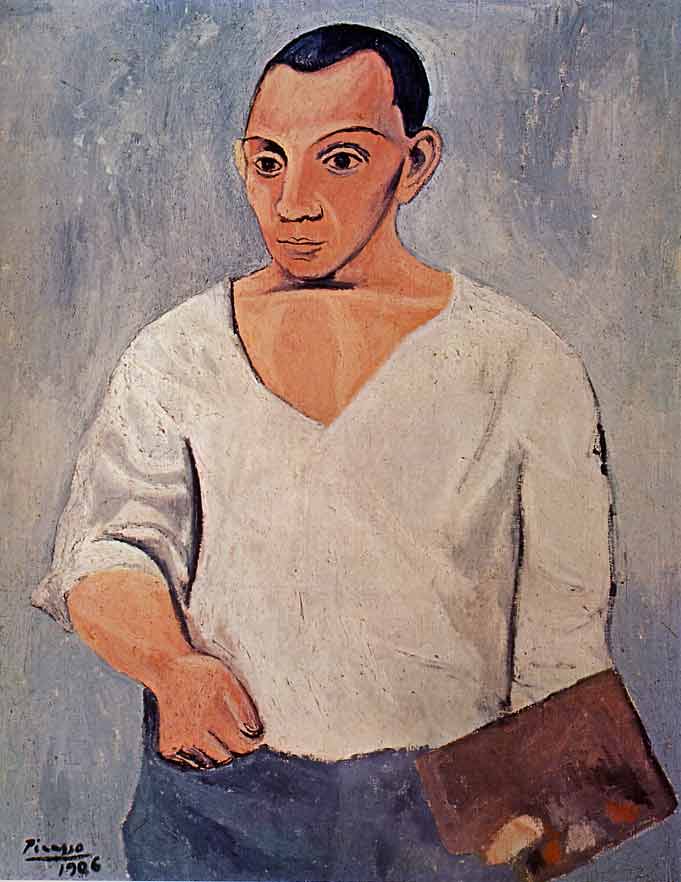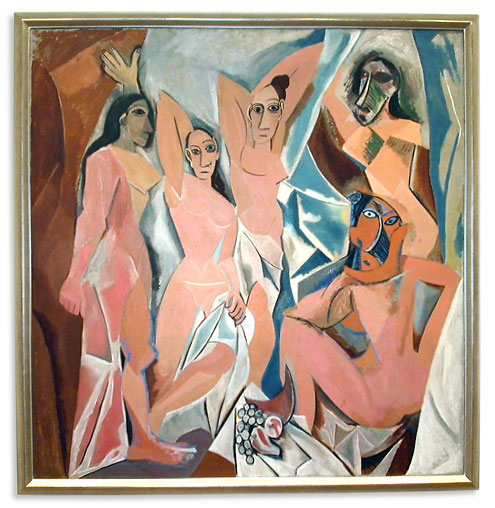Picasso Art Lesson
 b. 1881, Málaga, Spain;
d. 1973, Mougins, France
b. 1881, Málaga, Spain;
d. 1973, Mougins, FrancePablo Diego José Francisco de Paula Juan Nepomuceno María de los Remedios Crispín Crispiniano de la Santísima Trinidad Ruiz y Picasso was born in Spain in 1881. He is one of the most recognized figures in twentieth century art. He is best known as the co-founder, along with Georges Braque, of cubism.
Picasso, known not only for innovation, but for making great quantities of art, has, according to estimates, produced about 13,500 paintings or designs, 100,000 prints or engravings, 34,000 book illustrations and 300 sculptures or ceramics.
History
Pablo Picasso was born on October 25, 1881, in Málaga, Spain. The son of an academic painter, José Ruiz Blanco, he began to draw at an early age. In 1895, the family moved to Barcelona, and Picasso studied there at La Lonja, the academy of fine arts. His visit to Horta de Ebro from 1898 to 1899 and his association with the group at the café Els Quatre Gats about 1899 were crucial to his early artistic development. In 1900, Picasso’s first exhibition took place in Barcelona, and that fall he went to Paris for the first of several stays during the early years of the century. Picasso settled in Paris in April 1904, and soon his circle of friends included Guillaume Apollinaire, Max Jacob, Gertrude and Leo Stein, as well as two dealers, Ambroise Vollard and Berthe Weill.

les demoiselles d'Avignon
His style developed from the Blue Period (1901–04) to the Rose Period (1905) to the pivotal work Les Demoiselles d’Avignon (1907), and the subsequent evolution of Cubism [more] from an Analytic phase (ca. 1908–11), through its Synthetic phase (beginning in 1912–13). Picasso’s collaboration on ballet and theatrical productions began in 1916. Soon thereafter, his work was characterized by neoclassicism and a renewed interest in drawing and figural representation. In the 1920s, the artist and his wife, Olga (whom he had married in 1918), continued to live in Paris, to travel frequently, and to spend their summers at the beach. From 1925 into the 1930s, Picasso was involved to a certain degree with the Surrealists, and from the fall of 1931 he was especially interested in making sculpture. In 1932, with large exhibitions at the Galeries Georges Petit, Paris, and the Kunsthaus Zürich, and the publication of the first volume of Christian Zervos’s catalogue raisonné, Picasso’s fame increased markedly.

Guernica
By 1936, the Spanish Civil War had profoundly affected Picasso, the expression of which culminated in his painting Guernica (1937, Museo Nacional Centro de Arte Reina Sofia, Madrid). Picasso’s association with the Communist Party began in 1944. From the late 1940s, he lived in the South of France. Among the enormous number of Picasso exhibitions that were held during the artist’s lifetime, those at the Museum of Modern Art, New York, in 1939 and the Musée des Arts Décoratifs, Paris, in 1955 were most significant. In 1961, the artist married Jacqueline Roque, and they moved to Mougins. There Picasso continued his prolific work in painting, drawing, prints, ceramics, and sculpture until his death April 8, 1973.
Questionnaire
Answer the following questions in complete sentences:
- What are the birth and death dates for Picasso?
- Where was he born?
- Where did he study?
- Who did he study with?
- What countries did Picasso live in throughout his life?
- What museums and other institutions show Picasso's artwork to the public?
- Which of Picasso's paintings is considered his most important artwork?
- What is cubism?
- How did cubism develop?
- Who were Picasso's collaborators?
Description
Choose one work of Picasso's art and describe it for someone who has never seen it.
- Make statements about the art that can be verified by looking at the art.
- Use terms and ideas from your review of the elements and principles of design.
- Insert an image of the artwork on a web page with your writing.
- Post your work on your web site.
Report
Write a report about cubist art; write about …
- An artist, such as Pablo Picasso, Georges Braque or one of their contemporaries; or
- An artwork; or
- One of Picasso's "periods"
- The movement’s legacy on twentieth century art; or
- The general history of the art.
- Write between 250 and 700 words; think of quality, not quantity.
- List your reference sources in a bibliography and or a "works cited" section.
- Post your work on a web page on your web site.
Image
Create a Picasso-like, Cubist artwork.
- Use Adobe Illustrator
- File>New>5"x7">CMYK
- Include several techniques you have already learned:
|
basic shapes ~
|
blending ~
|
airbrush effects ~
|
Links
The following links will help you find out more about Picasso:
Picasso official web site
Picasso at Wikipedia
Picasso at time.com
Picasso in the Guggenheim Collection in New York city
Picasso quotes
Picasso biography
Museo Picasso Málaga en español y en ingles















